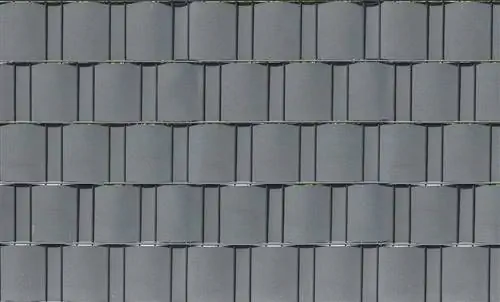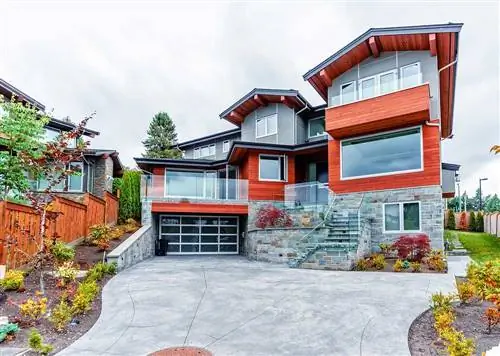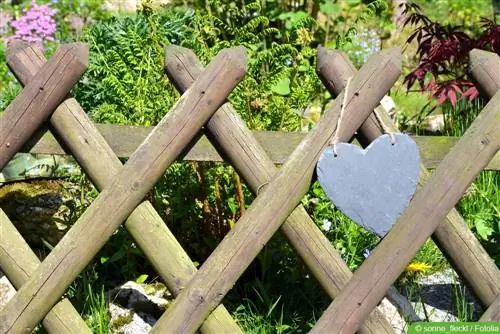- Author admin [email protected].
- Public 2023-12-17 03:39.
- Last modified 2025-06-01 06:48.
Privacy fences protect privacy, they provide wind protection and are often intended to keep out noise. However, the privacy fence is also under constant attack: the forces acting on the privacy surface pull on the anchoring and fatigue the material of the surface, connections and posts. When planning the privacy fence, its width, height and the expected wind load must be taken into account. What should you pay attention to when setting up privacy screens, posts and anchoring?
Protection and design of the privacy fence
When setting up the privacy fence, the focus is on privacy and weather protection. The privacy fence can divide the garden into areas of use or block the view of an unattractive environment. In addition to delimiting the terrace, pool and sun area, appropriately high protective fences can provide shade. Privacy fences are at least 1.40 meters high. To provide sufficient privacy, heights of 1.80 meters or more are chosen. Depending on the region and federal state, structural restrictions on setting up a privacy screen can limit both the height and design. If the privacy fence is set up on the border with the neighbor, you should ask the building authority about the distance and permissible height or obtain a building permit. Within the neighborhood, the planned privacy protection must be “customary to the area” and match the overall appearance of the development.
Criteria for planning
- Privacy protection from 1.40 meters high
- Local design, building permit may be required
- Stability under wind load
- Anchoring in the ground
- Materials for visibility, wind and noise protection
The privacy fence has to withstand high loads and the supposedly most stable and resilient material is not always windproof and stormproof. The privacy fence blocks out the wind. This puts a lot of pressure on the privacy protection elements. It is often forgotten that, in addition to the physical “avoidance maneuvers” of strong winds, flowers and plants also require a regular breeze. On the one hand, setting up a privacy screen can protect the plants from unfavorable weather conditions; on the other hand, plants need the wind, which plays an important role in pollen flow and pollination. With a privacy fence that is completely impermeable to air, the wind moves upwards and creates unpleasant eddies of air on the other side of the fence. The privacy screen must be as windproof and stormproof as possible, but should also take into account the biological microclimate of the planting.
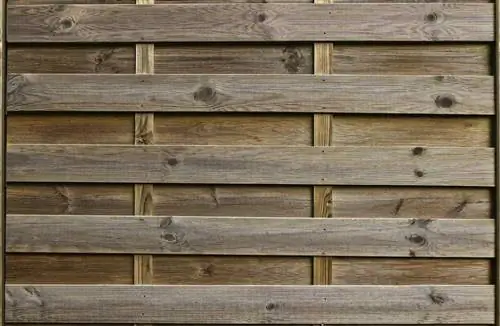
Tip:
Plants susceptible to fungus, such as roses, benefit from a fresh breeze.
Materials for stable privacy fences
Visually, the material should match the style of the property. Fences made of glass, wood, bamboo and woven structures made of plastics and metals are available. Since outdoor wood is maintenance-intensive and less durable, alternative materials made of plastic and stone are becoming popular. WPC (Wood Plastic Composite) is a plastic composite material that impresses with its wood look and is easy to clean and durable. A privacy screen made of window plastic is more robust. When selecting a suitable material, in addition to weather resistance, the ability to shorten the length and height can also be important.
The stone gabion fence guarantees absolute privacy. The stone fences piled up in the retaining grids to delimit barbecue areas or pool areas are very decorative. No care is required to maintain stability. On the terrace, however, an opaque privacy fence takes away a lot of natural light from the interior. A privacy fence made of glass that is completely or only partially opaque is advantageous. The popular privacy screen made from living plants, however, requires constant care. In addition, the naturally grown privacy screen is not very windproof or storm-proof and is only suitable for places protected from the weather. The same applies to the flexible fences. The privacy screen made of awning fabric is pulled out horizontally over the desired area. This makes side arm awnings ideal for small balconies, as they also have limited windproof retraction and security depending on the weather.
Tip:
Combine different privacy protection materials, such as plants with stones and plastic fences.
Set up a privacy fence - important information when choosing a height
A sufficient height of the privacy screen is necessary if it is not only intended to serve as privacy and weather protection, but also as sound insulation. Road traffic and constant noise can affect the quality of life. Particularly on small building plots, privacy walls often have to take on additional tasks, such as noise protection. For stability, particularly high wind protection and privacy fences have small openings and slots to allow the wind to pass through in a weakened form. The shape and weight of the foundation significantly influence the stability of the privacy fence. With a wind speed of 5 meters per second, there is already almost two kilos of wind pressure on one square meter of the privacy screen. At 20 meters/second (wind force 8 Beaufort) it is already almost 30 kilos per square meter. Hurricane-like winds do not only occur in mountainous areas or near the coast.
At heights of 1.50 meters or more, the wind load increases significantly and the usual impact ground sleeves are no longer sufficient for a windproof and stormproof construction. H and U post supports embedded in concrete are usually used for high fences (point foundations). For high fences and strong wind loads, a material thickness of 5 or 6 millimeters should be chosen for the post base. If the supports can be connected to a stable foundation, post supports for dowelling are also possible. A gap is left when connecting the privacy elements. Even a gap about 1 centimeter wide can let wind through and thus relieve the attack surface. Although the effect is limited, the sum of the measures ultimately contributes to stabilizing the privacy screen.
Tip:
Combine privacy screen elements at different heights.
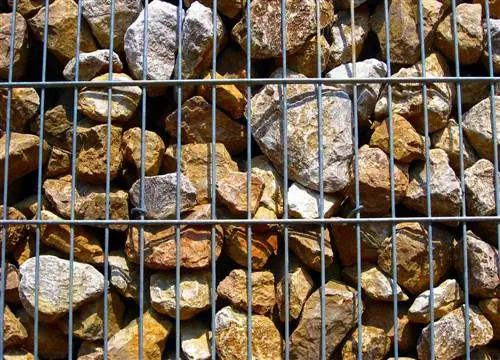
Set up a privacy fence in a windproof and stormproof manner
The material and height of the privacy fence also determine the required ground fastening. Due to the large area exposed to wind and the resulting wind load, the privacy walls must be firmly connected to the ground.
Impact Ground Sleeves
For fences over 150 centimeters high, the commonly used impact ground sleeves are hardly suitable for permanent fastening. They can no longer adequately dissipate the wind forces that occur. High fences can be attached to a nearby wall if necessary. The ground foundation of the wall should be 60 to 80 centimeters deep.
Point foundations
Point foundations are often created to attach higher privacy fences. As with the construction of carports, the fence posts are embedded in the concrete foundations. For point foundations, the soil should not be too soft or wet. The point foundations must be created at a sufficient depth.
Plinth wall
If the privacy screen is set up on the street side or on sloping terrain, a base wall is always recommended. In winter, snow is pushed to the sides of the street, which puts additional strain on the anchoring of a privacy screen. The base wall is built 30 to 40 centimeters high.
Foundations against earth pressure
A base wall is also recommended if the terrain slopes 30 centimeters or more towards the street or neighboring property. When there is a slope, the point foundations still hold their elements in place, but the foundations cannot absorb changes in earth pressure.
Cemented foundations embedded in the ground move minimally with the wind via the support posts. If the soil is not sufficiently secured, the natural movements will further expand the scope of the foundations. To ensure that the fastening in the ground lasts permanently, the soil properties must be taken into account when planning the foundations. An increasing water content in the soil, e.g. B. after persistently wet weather, can have a destabilizing effect on the soil properties. Buoyancy forces can arise or the soil structure can lose cohesion.
Secure privacy fence with storm anchor
Another option for stabilizing the posts is using additional support posts that are attached at an angle and are firmly anchored. Storm anchors made of galvanized steel have proven to be effective. Storm anchors equipped with ground spikes stabilize the individual elements of the privacy fence. The storm anchor is secured with screws in the post concrete and also in the ground via the ground spike. As with support posts, additional stability is achieved through an inclined fastening. The hot-dip galvanizing of the storm anchors offers a high level of corrosion protection. A typical storm anchor has a length of around 60 to 65 centimeters and a ground spike of around 70 centimeters. Storm anchors can be pegged and hammered in.
For very long privacy walls, the wind load can be interrupted by leaving out elements. The loosening in the privacy wall allows some of the wind to pass through. For example, a small gap is left after two privacy screens.
Tip:
Plant wind gaps with dense evergreen shrubs or cypresses.
Privacy fences - how do you achieve good stability?
- Solid soil condition
- Plan for wind gaps
- Fastening beams in foundations
- Foundation depth of 60 centimeters
- High-quality connections between elements and masonry
- high-quality element profiles, e.g. B. made of aluminum
So that the privacy fence is windproof and stormproof, a firm anchor is not enough. When setting up, the elements must be firmly connected to each other. Stapled connections of privacy protection elements quickly dissolve under stress. Connections with stainless steel screws can withstand even greater loads, are weatherproof and do not rust. The stability of the privacy protection elements is ensured by the frame orthe profiling. If they are too thin and light, the entire structure will become unstable even in light winds. Free-standing privacy elements, so-called cutouts, can be extended laterally as desired. Individual elements of a modular system are precisely connected to each other along the entire privacy protection route. Modules can be used to easily create privacy protection variations with different heights, arches, gates and passages. However, if less solid materials are used for privacy protection, the profiles of the individual elements must be particularly stable.
Privacy fences must be anchored in the ground for safety reasons and to compensate for the wind load. When setting up the privacy fence, the wind permeability of the material and elements must also be taken into account. The less wind can pass through the privacy screen, the greater the pressure on the material and the support posts. A privacy fence that is windproof and stormproof will need to allow some wind to pass through.

